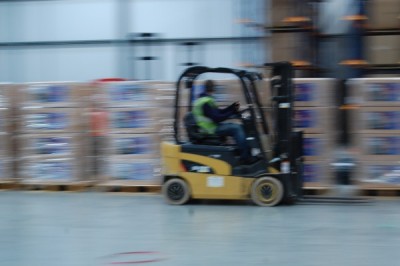Making sure spare parts are available is essential for any vehicle to stay in top class condition. This is even more so for the complex fighting machines of the UK Armed Forces. The traditional solution is keeping a stock of those vital spare parts all stored, neat and tidy, ready when needed. But MOD is always looking for innovative for ways to reduce costs, and particularly reduce the amount it spends on inventory each year, all while ensuring the vehicles remain well maintained and operational.
Early last year, the MOD signed up to an initial programme with defence company Finmeccanica – Selex ES with the aim of removing the need for a big warehouse full of spare parts. As a pilot project, the MOD team looking after the RAF switched a small portion of its spares' needs  to a ‘just-in-time’ availability service: Selex decides what to buy and when and where they should be delivered. All parts are airworthy, fully traceable and undergo rigorous procurement and Quality Assurance processes.
to a ‘just-in-time’ availability service: Selex decides what to buy and when and where they should be delivered. All parts are airworthy, fully traceable and undergo rigorous procurement and Quality Assurance processes.
The pilot programme was a big success, and recently MOD signed up for a widely expanded version of the service, covering 15 aircraft types stationed at over 45 operating bases.
Under the contract, the MOD will no longer have to order spare parts; instead Selex will ensure that parts are there when they are required. Of course while this may seem like science fiction or magic, it is all based on solid scientific method. The company uses advanced computer modelling and predictive forecasting - working out in advance when the MOD is likely to need a part so that it can have its partner Astute (who do the physical ordering and delivery), have the appropriate parts arrive on time.
The modelling looks at a number of factors that require more spares and uses tested algorithms to make predictions. It is the computerised equivalent of assuming that if you get through a pint of milk every week in numerous cups to tea, then you know that you'll need a new pint of milk to arrive in your fridge at the weekend. The elaborate computer models take this simple concept and apply it to the rather more complicated problem of keeping 15 types of aircraft ready to fly!
There’s also a real-time element, so if it looks like some parts are going to be needed earlier than expected, fail-safes in the system kick in and make sure the spares are there when they are needed.
The upshot of all this modelling and prediction is that the MOD needs less warehouse space and can save on costs, while preserving the same level of availability of parts for its vehicles.
When it comes to spare parts, we’re not quite at the science fiction level of technology where pressing a button causes a spare to be 'created' there and then - although with 3D printing, who knows what could happen in the future?! But, with smart computer modelling and ‘just-in-time’ supply chains, the MOD is reducing the need for warehouses full of spares – an innovative and cost saving solution to keeping vehicles on the road, in the air and wherever they are needed.
